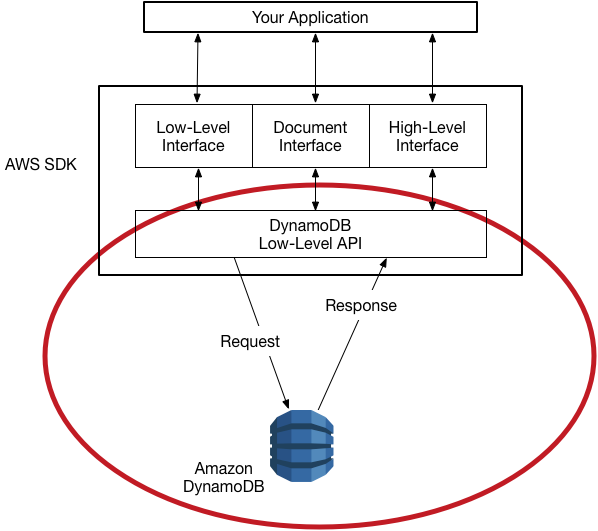DynamoDB low-level API - Amazon DynamoDB (original) (raw)
The Amazon DynamoDB low-level API is the protocol-level interface for DynamoDB. At this level, every HTTP(S) request must be correctly formatted and carry a valid digital signature.
The AWS SDKs construct low-level DynamoDB API requests on your behalf and process the responses from DynamoDB. This lets you focus on your application logic, instead of low-level details. However, you can still benefit from a basic knowledge of how the low-level DynamoDB API works.
For more information about the low-level DynamoDB API, see Amazon DynamoDB API Reference.
The low-level DynamoDB API uses JavaScript Object Notation (JSON) as a wire protocol format. JSON presents data in a hierarchy so that both data values and data structure are conveyed simultaneously. Name-value pairs are defined in the format name:value. The data hierarchy is defined by nested brackets of name-value pairs.
DynamoDB uses JSON only as a transport protocol, not as a storage format. The AWS SDKs use JSON to send data to DynamoDB, and DynamoDB responds with JSON. DynamoDB does not store data persistently in JSON format.
Note
For more information about JSON, see Introducing JSON on the JSON.org website.
Topics

Request format
The DynamoDB low-level API accepts HTTP(S) POST requests as input. The AWS SDKs construct these requests for you.
Suppose that you have a table named Pets, with a key schema consisting ofAnimalType (partition key) and Name (sort key). Both of these attributes are of type string. To retrieve an item fromPets, the AWS SDK constructs the following request.
POST / HTTP/1.1
Host: dynamodb.<region>.<domain>;
Accept-Encoding: identity
Content-Length: <PayloadSizeBytes>
User-Agent: <UserAgentString>
Content-Type: application/x-amz-json-1.0
Authorization: AWS4-HMAC-SHA256 Credential=<Credential>, SignedHeaders=<Headers>, Signature=<Signature>
X-Amz-Date: <Date>
X-Amz-Target: DynamoDB_20120810.GetItem
{
"TableName": "Pets",
"Key": {
"AnimalType": {"S": "Dog"},
"Name": {"S": "Fido"}
}
}Note the following about this request:
- The
Authorizationheader contains information required for DynamoDB to authenticate the request. For more information, see Signing AWS API requests and Signature Version 4 signing process in the_Amazon Web Services General Reference_. - The
X-Amz-Targetheader contains the name of a DynamoDB operation:GetItem. (This is also accompanied by the low-level API version, in this case20120810.) - The payload (body) of the request contains the parameters for the operation, in JSON format. For the
GetItemoperation, the parameters areTableNameandKey.
Response format
Upon receipt of the request, DynamoDB processes it and returns a response. For the request shown previously, the HTTP(S) response payload contains the results from the operation, as shown in the following example.
HTTP/1.1 200 OK
x-amzn-RequestId: <RequestId>
x-amz-crc32: <Checksum>
Content-Type: application/x-amz-json-1.0
Content-Length: <PayloadSizeBytes>
Date: <Date>
{
"Item": {
"Age": {"N": "8"},
"Colors": {
"L": [
{"S": "White"},
{"S": "Brown"},
{"S": "Black"}
]
},
"Name": {"S": "Fido"},
"Vaccinations": {
"M": {
"Rabies": {
"L": [
{"S": "2009-03-17"},
{"S": "2011-09-21"},
{"S": "2014-07-08"}
]
},
"Distemper": {"S": "2015-10-13"}
}
},
"Breed": {"S": "Beagle"},
"AnimalType": {"S": "Dog"}
}
}
At this point, the AWS SDK returns the response data to your application for further processing.
Note
If DynamoDB can't process a request, it returns an HTTP error code and message. The AWS SDK propagates these to your application in the form of exceptions. For more information, see Error handling with DynamoDB.
Data type descriptors
The low-level DynamoDB API protocol requires each attribute to be accompanied by a data type descriptor. Data type descriptors are tokens that tell DynamoDB how to interpret each attribute.
The examples in Request format and Response format show examples of how data type descriptors are used. The GetItem request specifies S for the Pets key schema attributes (AnimalType andName), which are of type string. The GetItem response contains a Pets item with attributes of typestring (S), number (N),map (M), and list (L).
The following is a complete list of DynamoDB data type descriptors:
S– StringN– NumberB– BinaryBOOL– BooleanNULL– NullM– MapL– ListSS– String SetNS– Number SetBS– Binary Set
Note
For detailed descriptions of DynamoDB data types, see Data types.
Numeric data
Different programming languages offer different levels of support for JSON. In some cases, you might decide to use a third-party library for validating and parsing JSON documents.
Some third-party libraries build upon the JSON number type, providing their own types such as int, long, or double. However, the native number data type in DynamoDB does not map exactly to these other data types, so these type distinctions can cause conflicts. In addition, many JSON libraries do not handle fixed-precision numeric values, and they automatically infer a double data type for digit sequences that contain a decimal point.
To solve these problems, DynamoDB provides a single numeric type with no data loss. To avoid unwanted implicit conversions to a double value, DynamoDB uses strings for the data transfer of numeric values. This approach provides flexibility for updating attribute values while maintaining proper sorting semantics, such as putting the values "01", "2", and "03" in the proper sequence.
If number precision is important to your application, you should convert numeric values to strings before you pass them to DynamoDB.
Binary data
DynamoDB supports binary attributes. However, JSON does not natively support encoding binary data. To send binary data in a request, you will need to encode it in base64 format. Upon receiving the request, DynamoDB decodes the base64 data back to binary.
The base64 encoding scheme used by DynamoDB is described at RFC 4648 on the Internet Engineering Task Force (IETF) website.